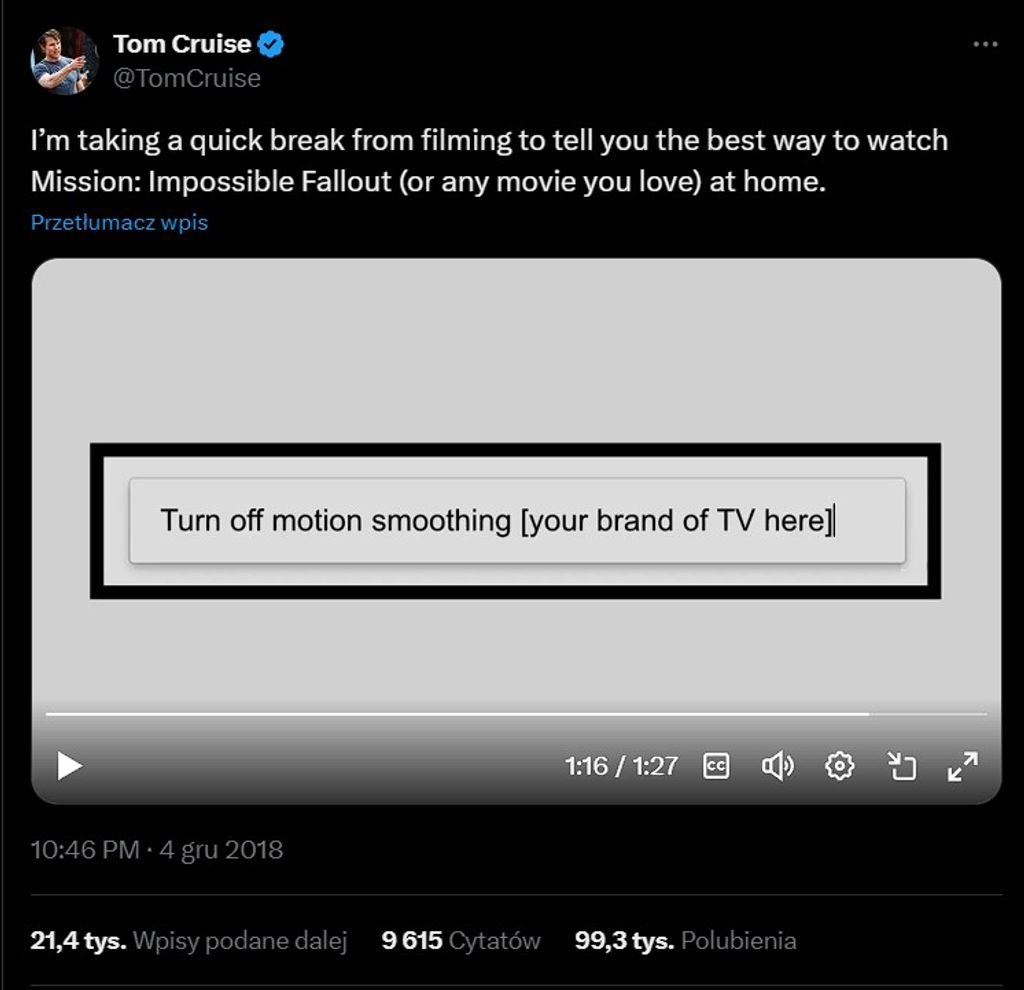
Almost every one of us has encountered the problem of pixelation during fast movements, clipping, or excessive smoothness known as the soap opera effect after purchasing a new television. This is also a frequently discussed issue by our clients during calibration. In fact, even Tom Cruise himself pointed out this problem at the premiere of the next Mission Impossible installment back in 2018 on platform X. He recommended turning off motion smoothing, which distorts the image. Since even such an outstanding figure has noted this issue, let’s see how we can change it on our television.


So how can we eliminate the discussed problems? In short, we need to adjust the image fluidity system. However, every choice in the settings will have its pros and cons. Therefore, we will try to show how anyone can come to a compromise on this matter.
What is a fluidizer and how does it work?
Motion smoothing systems have been around for many years, and each manufacturer uses practically a different name for this solution. Below are the most commonly encountered:
Auto Motion Plus
TruMotion
Perfect True Motion
Motionflow
Intelligent Frame Creation
Clarity of Motion
Regardless of the name of a given system, its goal is to generate additional frames of the image that are inserted between those naturally coming from the film. The TV then attempts to estimate the trajectory of moving objects and generates them between the starting and ending positions.
Quite clever, right? However, the benefits that come from this system depend on the type of material we are watching at that moment.
In general, we can distinguish 2 separate types of materials - low frame rate (up to 30fps) and high frame rate materials (above 50fps).
Low-frame materials
Low-frame-rate materials mainly refer to films and series recorded at a standard of 24fps, which has been with us since the dawn of time. Due to this characteristic number of frames, which is too small for the image to appear fluid, we often see the familiar cinematic stutter during quick camera movements.
It is possible that we do not notice this effect in our daily life because over the years of watching various materials, we have simply gotten used to it. However, we can pay attention to it, especially when the camera operator performs a panning shot, which means moving the entire frame horizontally or vertically. In that case, image smoothing technology comes to our aid.
But if it worked perfectly, we would have no reason to write this article ;)
When this function operates at full capacity, the image may appear too smooth, which is often referred to as the soap opera or theater effect. This is particularly evident during character movements, where the smoothness can simply look artificial. This is because the movements of the human body, for example facial expressions, do not have a definitive tempo. Therefore, the operation of the smoothener in this case can irritate us with its artificiality.
High-frame materials
High frame rate materials are those recorded at 50fps or more. They are most often live content or sporting events, e.g., matches. This seems logical because it would be difficult to watch the clash of our favorite clubs with constant tearing and jumping of the field during camera movements. With such materials, the use of a motion smoother aims to improve sharpness - the more frames, the clearer the image during dynamic movement on LCD and OLED screens. The reason for this is the way these screens operate, but we can discuss that maybe another time :)
Adding new frames in such content is only possible on displays above 120Hz, because at 60Hz the system simply wouldn’t have anywhere to insert them. This leads to the conclusion that if we completely turn off the motion smoothing system, while watching television we are only using 60Hz of our 120Hz display. Following this logic, with high frame rate material, the motion smoothing should work at full capacity, and we also recommend doing so.
However, when we expect a significant intervention, the more artifacts will be generated, which will be visible on the edges of rapidly moving objects. In extreme cases, this can cause choppiness or bending of objects that are in motion, which unfortunately gives us the opposite effect to what was intended.
Now let’s see how we can appropriately configure these settings for individual manufacturers.
LG
In LG televisions, the motion smoother is called TruMotion and is located at the bottom of the menu named 'Clarity'. By selecting the "User Choice" option, we have access to two sliders - De-Judder and De-Blur.
The first one is responsible for the interpolation of low-frame-rate materials, and the second for high-frame-rate ones. To put it simply, De-Judder is responsible for fluidity in films, while De-Blur is for reducing blur in sports.
If we are bothered by the choppiness of the image, we adjust it with the first slider, but if the image becomes too artificially smooth, we reduce this value. The second slider is best set to the maximum value, but if we frequently see pixelation around moving objects, we need to consider decreasing it.
For LG TVs with a 60HZ panel, only the De-Judder slider will be available due to the lack of the ability to add new frames, which we mentioned earlier.
Samsung
Samsung named this feature Auto Motion Plus and also has a precise configuration divided into two sliders. To access this, one should go through Picture->Expert Settings->Picture Clarity Settings->User. Blur reduction is responsible for low frame rate materials, while judder reduction is for high frame rate materials.
It is worth noting that Samsung, as the only manufacturer on the market, has a dedicated game motion smoother system. We can set this up by going sequentially:
External Settings Manager -> Game Mode Settings -> Game Mode -> Enabled.
Then at the very bottom, the option "Motion Plus Game Settings" becomes active, which we need to enter to make adjustments. We will see the sliders known from before. This will improve the smoothness of content at both 30fps and 60fps. This will not have any impact on input lag, as with this function enabled, it closes below 20 ms. This is possible due to the use of a different frame interpolation that does not have such a significant impact on signal delay.
TCL, Philips, Hisense, Panasonic
Among other manufacturers, the entry into the appropriate settings is similar. To display the two sliders we have encountered before, you need to choose as follows:
TCL: Advanced video settings->Motion->Motion clarity
Philips: Picture->Motion->Motion style - Personal
Hisense: Picture->Motion->Ultra motion smoothness - Custom
Panasonic: Picture->Advanced video options->MJC-> Effect (in this case, we do not have a manual option to adjust smoothness)
Sony
In the case of Sony brand televisions, the ability to adjust smoothness may be represented by a single slider - Smoothness. Why did we say may? In the A95L, this has already been improved, so the rest of the models for this year will likely not struggle with this problem. During testing in our studio, this update was not yet available.
At that time, we only had one variable available, which regulated the level of interference in low-frame and high-frame materials; it was not separated as in the aforementioned competition.
If we want to set the appropriate smoothness for sports content, it is best to set the slider to a value of 2. However, this may result in an artificial effect in movies and series. For this type of content, we recommend setting it to a value of 1. In this case, we will not find a compromise, so we have to accept it or manually change the settings according to the material currently being viewed.
In televisions of other brands or slightly older devices, the settings will be located in similar menu sections, so you should not have any problem finding them.
Of course, the issue of traffic fluidizer settings is a subjective matter, but we wanted to show and explain how this technology works and whether a compromise can be found that allows us to achieve a satisfactory effect. Try, test, and let us know what settings you prefer.














